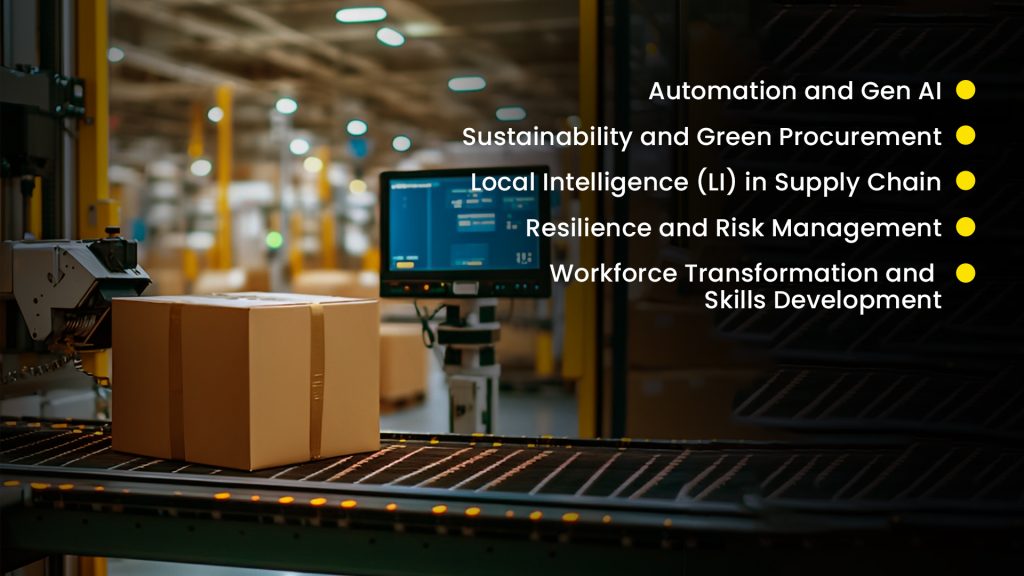5 Supply Chain Trends In 2025 For The Procurement Market
The business landscape is in a state of constant flux, embracing high-impact terms, technologies, and practices to stay viable and profitable. Such adaptations in operational strategies are extremely essential to ensure substantial improvements and stay ahead of the competition while matching superior industry protocols and supply chain industry trends. The supply chain in the sourcing market is a particular aspect that is on the cusp of transformation with cloud and AI-based solutions. This helps navigate business challenges and boost their future capabilities. Given these lucrative benefits, the global supply chain management market is projected to reach nearly $31 billion by 2026, which encourages investment in this particular vertical.
Stepping into 2025, sourcing processes continue to transform due to rapidly advancing technologies, customer behaviors, and uncertain geopolitical shifts. Thus, it particularly becomes crucial to maintain the supply chain’s sync with the evolving standards to streamline the intricate complexities of worldwide sourcing. Any product sourcing company will benefit by reducing dependency on one resource, introducing new technology, and moving towards customer-centric supply chain management strategies. It gradually helps businesses streamline operations, decreasing costs and improving customer demands.
Below is a list of upcoming trends in the supply chain in the procurement market that every business must consider for strategic sourcing initiatives.

1. Automation and Gen AI : Gen AI and ML tools move toward autonomous workflows rather than simple task automation. These tools make better decisions based on real-time information and predictive analytics for any commodity. Right from managing risk with suppliers to predicting demand, they manage mundane duties to enable your procurement teams to focus on strategic goals. These systems will eventually make the procurement process highly digitalized in the future.
In 2025 global spending on supply chain technologies is poised to exceed $19 billion annually. To do well, a company should invest in AI-powered procurement tools that offer automation of repetitive tasks and improved accuracy in supply and demand planning. Organizations should focus on upskilling their existing workforce with training around AI usage and enhancing data infrastructure to support seamless supply chain operations.
2. Sustainability and Green Procurement : With time, emphasis on ESG (Environmental, Social, and Governance) goals has surged manifold. Both investors and consumers need their products and product sourcing to be environmentally sound, reducing ecological footprints and adapting carbon sequestration strategies. This will intensify in the coming years as governments are also becoming stricter with every policy and consumers prioritize sustainability.
To stay ahead, organizations should adopt circular supply chains that emphasize recycling, reusing, and reducing waste. Must implement renewable energy sources, energy-efficient logistics management, and eco-friendly manufacturing processes. Also, collaborating with suppliers and vendors who stick to green practices and regularly audit their sustainability performance.
3. Local Intelligence (LI) in Supply Chain: It is a subset of supply chain intelligence that uses geospatial data to gain insights into the market and make business decisions. An emerging critical factor in optimizing supply chain management processes, such as the flow of goods, services, and information, is using demographics, real estate information, and geographical data to identify the most efficient delivery routes and enhance distribution strategies, keeping in mind the potential risks and location-specific disturbances like weather and geopolitical issues.
To stay ahead, businesses should invest in geographic information systems (GIS) and spatial analytics tools to get better location and market insights, integrate LI into decision-making processes for logistics management systems and distribution of their customers, suppliers, and operations, and collaborate with technology providers to enhance real-time monitoring and predictive capabilities.
4. Resilience and Risk Management: These two are fundamental processes that help businesses foresee and respond to disruptions in their supply chains. The major characteristic of a resilient supply chain is agility, which is achieved when a company can predict future risks. Durable supply chain services are essential for companies if they want to recover from interruptions quickly and remain highly competitive. Moreover, a company must be resilient to supply chain disruptions, which is what allows for the conversion of such disruptions into opportunities.
To diversify risk and become resilient, it’s always advisable to ensure a well-varied supplier network and maintain strategic reserves for essential raw materials. Moreover, investing in dual-sourcing strategies or identifying issues of potential suppliers and acting proactively to navigate all these dangers, all while keeping good plans to allow continued business operations.
5. Workforce Transformation and Skills Development: As quickly as supply chains are evolving with the inclusion of technology, the need for transforming, or say upskilling, the existing workforce becomes a necessity to stay relevant in the current scenario. This is because the procurement market needs a combination of authenticity and digital fluency to survive in the marketplace.
To leave competitors behind, professionalizing employees by investing in training programs is essential. They are focused on data analysis, digital tools, and strategic sourcing along with encouraging collaboration between procurement, IT, and other departments to drive innovation. These can help product sourcing companies tackle the evolving upheavals.
Conclusion:
The procurement market in 2025 will be influenced by technological innovation, ecological requirements, and changing consumer and geopolitical landscapes. Companies must play at their proactiveness by looking for the latest technologies to develop their sustainable and robust supply chains and create cooperation among stakeholders.
Implementing the previously mentioned strategies would allow companies like us at Inductus to become the leaders in the transformation of the procurement function. The time is ripe for action and making bold steps toward the future to stay at the top of the competition in supply chain management.








